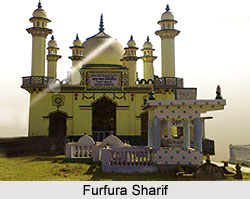 Furfura Sharif, also known as Furfura, Phurphura is a village considered to be very holy by the Muslims. It is located in Jangipara community development block of Srirampore subdivision in Hooghly District in West Bengal. Furfura is located at 22degree44`N 88degree08`E? / ?22.74degreeN 88.13degreE / 22.74; 88.13.
Furfura Sharif, also known as Furfura, Phurphura is a village considered to be very holy by the Muslims. It is located in Jangipara community development block of Srirampore subdivision in Hooghly District in West Bengal. Furfura is located at 22degree44`N 88degree08`E? / ?22.74degreeN 88.13degreE / 22.74; 88.13.
There are many villages in Furfura panchayat like Furfura, Purba Durgapur, Gopalnagar, Hosenpur, Dakshindihi, Rampara, Toralpur, Chak Barada, Belpara, Ramnagar, Nilarpur, Chaurpur, Bakcha, Kashipur, Ramchandrapur, Hazipur, and Bhimpur.
History of Furfura Sharif
Built in 1375, the mosque was built by Muqlish Khan. The mosque serves as a site for Muslim pilgrimage, especially during the Pir`s mela (fair). The mosque is also visited by thousands of pilgrims during Urs festival.
The Muslims dwelling in this region are believed to be chiefly Ashrafs. They are thought to be the descendants of Muslims who invaded Bengal in the 14th century. According to history the Bagdi king who was the ruler of this region was defeated by Hazrat Shah Kabir Halibi and Hazrat Karamuddin. However, both of them were killed in the battle. Even today the tombs are revered by both Hindus and Muslims.
The Mazaar Sharif (Tomb) of Hazrat Abu Bakr Siddique(Rh) and his five sons, popularly known as the `Panch Huzur Keblah` is one the most significant place within Furfura Sharif. These tombs are visited by Thousands of people from all over India come every year.
The order of Furfura-Sharif was founded by Sufi Saint Hazrat Abu Bakr Siddique. He was born in 1846 in Furfura-Sharif. He was a direct descendant of the first Khalif of Islam, Syedena Hazrat Abu Bakr Siddique RA. He belonged to the Ahle-Sunnat-Wal-Jamaat school of thoughts. Hazrat Abu Bakr Siddique was also the founder of the religious congregation, which is still observed on the 21st 22nd and 23rd of Falgun Bengali month every year by his grandsons. He was a religious preacher as well as a Mujadded-e-Zaman or Social and Religious Reformer of an era. He was better known by this title. Mujadded-e-Zaman Hazrat Abu Bakar Siddique was born in Furfura-Sharif in the year 1845. He remained absorbed in social work and worked hard for the upliftment of the masses and eradication of social evils from the society. He is credited with establishing several charitable institutes, orphanages and free health center for the poor masses. He was also a great educationist who believed that it is through education he can free the society of all evils. It was for this reason that he set up several madrasas, schools and learning centers. In Furfura Sharif he established Madrasa, along with free boarding facilities for the underprivileged students. He encouraged female education by establishing a School for girls in Furfura Sharif.
In the year 1939 on 17 March he passed away leaving behind his five sons,





















